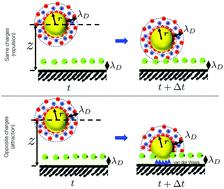当前位置:
X-MOL 学术
›
Phys. Chem. Chem. Phys.
›
论文详情
Our official English website, www.x-mol.net, welcomes your feedback! (Note: you will need to create a separate account there.)
Colloidal particle deposition on microchannel walls, for attractive and repulsive surface potentials.
Physical Chemistry Chemical Physics ( IF 3.3 ) Pub Date : 2020-07-09 , DOI: 10.1039/d0cp01999b Tatiana Porto Santos 1 , Rosiane Lopes Cunha , Patrick Tabeling , Cesare M Cejas
Physical Chemistry Chemical Physics ( IF 3.3 ) Pub Date : 2020-07-09 , DOI: 10.1039/d0cp01999b Tatiana Porto Santos 1 , Rosiane Lopes Cunha , Patrick Tabeling , Cesare M Cejas
Affiliation

|
Surface interactions are an interplay of van der Waals adhesion forces with electrostatic charges. In colloidal deposition, at low ionic strengths, the Debye layer is sufficiently large to prevent particles from approaching the surface. It is only with the addition of higher salt concentrations, typically above 0.1 M, that surface charges are screened for interactions to take place via van der Waals-adhesion forces. This is true for repulsive charges, when both surfaces have similar charges and signs of the zeta potential are the same. However, with attractive charges, where zeta potential signs are opposite, the result is also opposite. By combining microfluidic experiments, theory, and numerical simulations, results show that when charges are attractive, particle deposition instead increases at low ionic strengths (at greater Debye lengths), at rates controlled by van der Waals forces but assisted by electrostatic forces. We propose a mechanism where particles approach the wall, mobilized by electrostatic attraction, up to a distance where van der Waals forces come into play, collecting the particles at the wall, which electrostatic forces alone are unable to achieve, owing to hindered diffusion. The present work thus allows us to understand the different mechanisms that govern deposition in the case where surface charges are opposite.
中文翻译:

胶体颗粒沉积在微通道壁上,具有吸引和排斥的表面电势。
表面相互作用是范德华力与静电电荷的相互作用。在胶体沉积中,在低离子强度下,德拜层足够大以防止颗粒接近表面。只有通过加入更高盐浓度,典型地高于0.1M,该表面电荷被筛选相互作用发生经由范德华粘附力。当两个表面都具有相似的电荷且zeta电位的符号相同时,对于排斥性电荷而言确实如此。但是,对于诱人的电荷(ζ电位符号相反),结果也相反。通过将微流体实验,理论和数值模拟相结合,结果表明,当电荷具有吸引力时,粒子沉积反而会以范德华力控制但受静电力辅助的速率在低离子强度(较大的德拜长度)下增加。我们提出一种机制,通过静电吸引使粒子接近壁,直至范德华力发挥作用的距离,将粒子收集在壁上,由于受阻扩散,仅静电力无法实现。
更新日期:2020-08-05
中文翻译:

胶体颗粒沉积在微通道壁上,具有吸引和排斥的表面电势。
表面相互作用是范德华力与静电电荷的相互作用。在胶体沉积中,在低离子强度下,德拜层足够大以防止颗粒接近表面。只有通过加入更高盐浓度,典型地高于0.1M,该表面电荷被筛选相互作用发生经由范德华粘附力。当两个表面都具有相似的电荷且zeta电位的符号相同时,对于排斥性电荷而言确实如此。但是,对于诱人的电荷(ζ电位符号相反),结果也相反。通过将微流体实验,理论和数值模拟相结合,结果表明,当电荷具有吸引力时,粒子沉积反而会以范德华力控制但受静电力辅助的速率在低离子强度(较大的德拜长度)下增加。我们提出一种机制,通过静电吸引使粒子接近壁,直至范德华力发挥作用的距离,将粒子收集在壁上,由于受阻扩散,仅静电力无法实现。



























 京公网安备 11010802027423号
京公网安备 11010802027423号